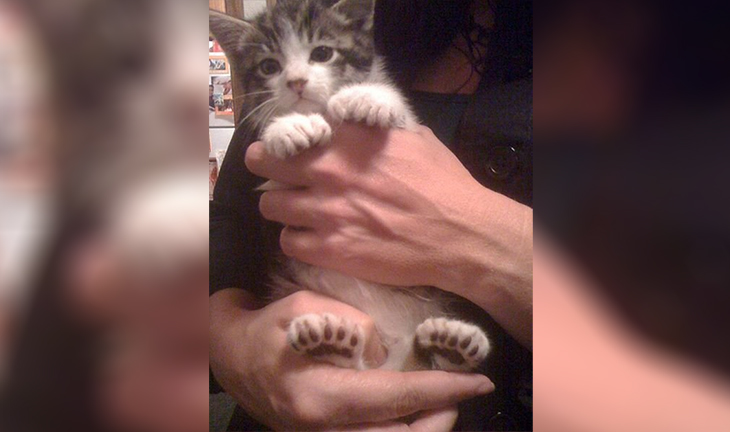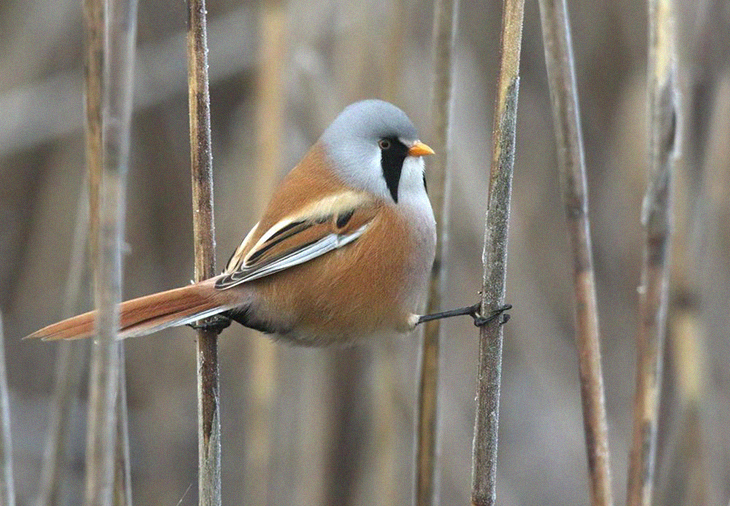By: Lili Feinn/The Dodo Our differences are what make us special. In a way, they are like superpowers. This is not only true for humans but animals, too.
Found on the streets of Portland, Oregon, a small kitten with unusual paws was dropped off at a veterinary clinic by a couple of kind passersby. The little kitten had long white fur, one blue eye, and one green eye, and to top it off, an extra toe on each of his front feet. At 6 weeks old, veterinarian Stephanie Harvey could tell this tiny ball of white fluff was different from the rest and named him Wallace.

Stephanie Harvey
Harvey knew that uniqueness was something to be cherished, and decided she and the odd little kitten were meant to be. “I see A LOT of kittens and had so far resisted taking any home with me, but Wallace was special and I had to have him,” Harvey told The Dodo.
Wallace has polydactylism, a genetically inherited trait that causes cats to be born with more than the usual number of toes on their paws. Cats typically have a total of 18 toes, explains New York City-based veterinarian Dr. Lisa Lippman: Five toes on each front paw and four on each hind paw, so anything extra makes a cat polydactyl. The extra equally sized toes tend to give the impression that polydactyl cats have big feet.

Howie831/Wikimedia Commons
Like most polydactyl cats, Wallace’s additional toes are only present on his forepaws. It is considered rare for cats to have extra toes on their hind paws, even moreso to have all four feet affected by the condition (though one Canadian polydactyl cat was found to have as many as 28 toes, seven on each paw).
Harvey quickly adopted the six-toed kitten, but all was not smooth sailing. The combination of Wallace’s large feet and his energetic personality seemed to land him in constant messes.
“We called him Wallace the Worst when he was a kitten because he would get into trouble: knocking over glasses of water with his big feet, chewing on cords,” Harvey said. “He likes to tear through the house and charge up and down the stairs for no reason.”

Stephanie Harvey
Polydactyl cats are most commonly seen along the East Coast of the U.S., Canada and even some parts of the UK, notes Lippman, making Wallace even more rare in the Pacific Northwest where Harvey found him.

Ventus55/Wikimedia Commons
How the genetic trait started and expanded is something of a mystery to this day. “How polydactyl cats came to be is up for debate, but there is general agreement that polydactyl cats were caused by a mutation that was carried on ships originating in Boston, which then spread them to a number of port cities soon after,” Lippman explains.
And spread they did.
Polydactyl cats once held a prize position aboard ships. Sailors and fishermen valued the large-pawed cats for their hunting and climbing abilities; the extra toes were thought to give the cats better balance on swaying vessels, and polydactyl cats were instrumental in keeping rodents at bay while out at sea. Some sailors even believed the cats to be good luck — and Harvey tells her clients the same thing.
The special cats even have a famous fan. Ernest Hemingway became an aficionado of polydactyl cats after being given one as a gift from a ship’s captain. The author’s Key West estate is now home to between 40 and 50 polydactyl cats, many of whom are descendants of the original cat, Snow White.
While the trait is not breed-specific, Maine Coons have a high rate of polydactylism, their wide paws said to act as a type of snowshoe.
Polydactylism is harmless on its own, but dangers lie in breeding for the trait, particularly when polydactyl cats are bred with cats that have other related conditions, such as feline radial hypoplasia.
“This can cause a cat’s bones to grow improperly — resulting, for example, in very short forelegs or very long hind legs. Sadly, breeding cats with this condition can result in offspring with severe disabilities,” Lippman explains.
Thankfully, Wallace’s paws do not cause him any problems, though he is definitely not a fan of nail trims. Since he traveled home with Harvey eight years ago, Wallace has (almost) grown into his large feet — even discovering ways to use them to his advantage.
“His superpower is catching bugs and moths that get into the house. He fancies himself a hunter extraordinaire,” Harvey said. “He is not allowed outside and so must settle for indoor hunting.”
https://www.instagram.com/p/BFkxMfwhTu2/
Where agility and fine movement are concerned, Wallace may still have some growing yet to do.
“Sometimes he looks like he thinks he is delicately tapping something (usually a bug) with his foot, but he has such huge feet that delicate tapping isn’t possible and he is inadvertently smashing the bug or toy,” Harvey added. “He doesn’t realize his own strength!”





